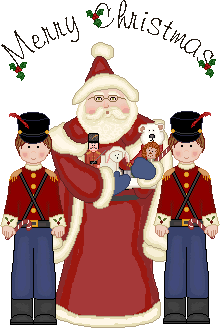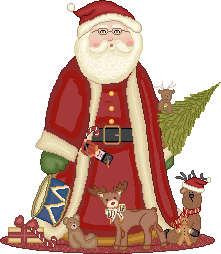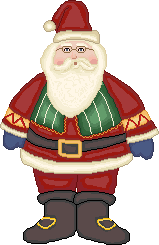 The Story
of Santa Claus
The Story
of Santa Claus
 |
"Today,
Santa Claus is generally depicted as a fat, jolly man with a
white beard, dressed in a red suit trimmed with white, and driving
a sleigh full of toys drawn through the air by eight reindeer.
Santa (also called Saint Nicholas and Saint Nick) is said to
visit on Christmas Eve, entering houses through the chimney to
leave presents under the Christmas tree and in the stockings
of all good children. Although this familiar image of Santa Claus
is a North American invention of the 19th century, it has ancient
European roots and continues to influence the celebration of
Christmas throughout the world. |
The
legend of Santa Claus had origins in Europe and was brought by
Dutch settlers to New York in the early 18th century. Traditionally,
Santa Claus - from the Dutch Sinter Klaas - was depicted as a
tall, dignified, religious figure riding a white horse through
the air. Known as Saint Nicholas in Germany, he was usually accompanied
by Black Peter, an elf who punished disobedient children. In
North America he eventually developed into a fat, jolly old gentleman
who had neither the religious attributes of Saint Nicholas nor
the strict disciplinarian character of Black Peter.
Santa's
transformation began in 1823, when a New York newspaper published
the poem “A Visit from Saint Nicholas,” which Clement
Clark Moore had written to amuse his daughter. The poem introduced
many Americans to the story of a kindly saint who flew over housetops
in a reindeer–drawn sleigh. Portraits and drawings of Santa
Claus by American illustrator Thomas Nast further strengthened
the legend during the second half of the 19th century.
Living
at the North Pole and assisted by elves, the modern Santa produced
and delivered toys to all good children. By the late 19th century
he had become such a prominent figure of American folklore that
in 1897, when Virginia O'Hanlon wrote to the New York Sun newspaper
asking if Santa were real, she received a direct answer: “Yes, Virginia, there is
a Santa Claus.”
-
Origins of the Legend -
|
The
historical Saint Nicholas was venerated in early Christian legend
for saving sailors, defending young children and giving generous
gifts to the poor. Although many of the stories about Saint Nicholas
are of doubtful authenticity, his legend spread throughout Europe,
emphasizes his role as a traditional bringer of gifts. The Christian
figure of Saint Nicholas replaced or incorporated various pagan
gift-giving figures such as the Roman Befana and the Germanic
Berchta and Knecht Ruprecht. The saint was called Sankt Nikolaus
in Germany and Sanct Herr Nicholaas or Sinter Klaas in Holland.
In these countries he was sometimes said to ride through the
sky on a horse. He was depicted wearing a bishop's robes and
was said to be accompanied at times by Black Peter, an elf whose
job was to whip the naughty children. |
 |
The
feast day of Nicholas, when presents were received, was traditionally
observed on December 6. After the Reformation, German Protestants
encouraged veneration of the Christkind (Christ child) as a gift
giver on his own feast day, December 25. When the Nicholas tradition
prevailed, it became attached to Christmas itself. Because the
saint's life is so unreliably documented, Pope Paul VI ordered
the feast of Saint Nicholas dropped from the official Roman Catholic
calendar in 1969. The term Christkindl evolved to Kriss Kringle,
another nickname for Santa Claus. Various other European Christmas
gift givers were more or less similar to Saint Nicholas: Père
Noël in France, Julenisse in Scandinavia, and Father Christmas
in England.
-
American Origins -
 |
The American
version of the Santa Claus figure received its inspiration and
its name from the Dutch legend of Sinter Klaas, brought by settlers
to New York in the 17th century. As early as 1773 the name appeared
in the American press as "St. A Claus," but it was
the popular author Washington Irving who gave Americans their
first detailed information about the Dutch version of Saint Nicholas.
In his History of New York, published in 1809 under the pseudonym
Diedrich Knickerbocker, Irving described the arrival of the saint
on horseback (unaccompanied by Black Peter) each Eve of Saint
Nicholas. This Dutch-American Saint Nick achieved his fully Americanized
form in 1823 in the poem A Visit From Saint Nicholas - more commonly
known as The Night Before Christmas - by writer Clement Clarke
Moore. |
Moore
included such details as the names of the reindeer; Santa Claus's
laughs, winks, and nods; and the method by which Saint Nicholas,
referred to as an elf, returns up the chimney. (Moore's phrase
"lays his finger aside of his nose" was drawn directly
from Irving's 1809 description.)
The
American image of Santa Claus was further elaborated by illustrator
Thomas Nast, who depicted a rotund Santa for Christmas issues
of Harper's magazine from the 1860s to the 1880s. Nast added
such details as Santa's workshop at the North Pole and Santa's
list of the good and bad children of the world. A human-sized
version of Santa Claus, rather than the elf of Moore's poem,
was depicted in a series of illustrations for Coca-Cola advertisements
introduced in 1931. In modern versions of the Santa Claus legend,
only his toy-shop workers are elves. Rudolph, the ninth reindeer,
with a red and shiny nose, was invented in 1939 by an advertising
writer for the Montgomery Ward Company."
 Microsoft ® Encarta ®
Online Encyclopedia 2001
Microsoft ® Encarta ®
Online Encyclopedia 2001
© 1997-2000
Microsoft Corporation. All Rights Reserved. |